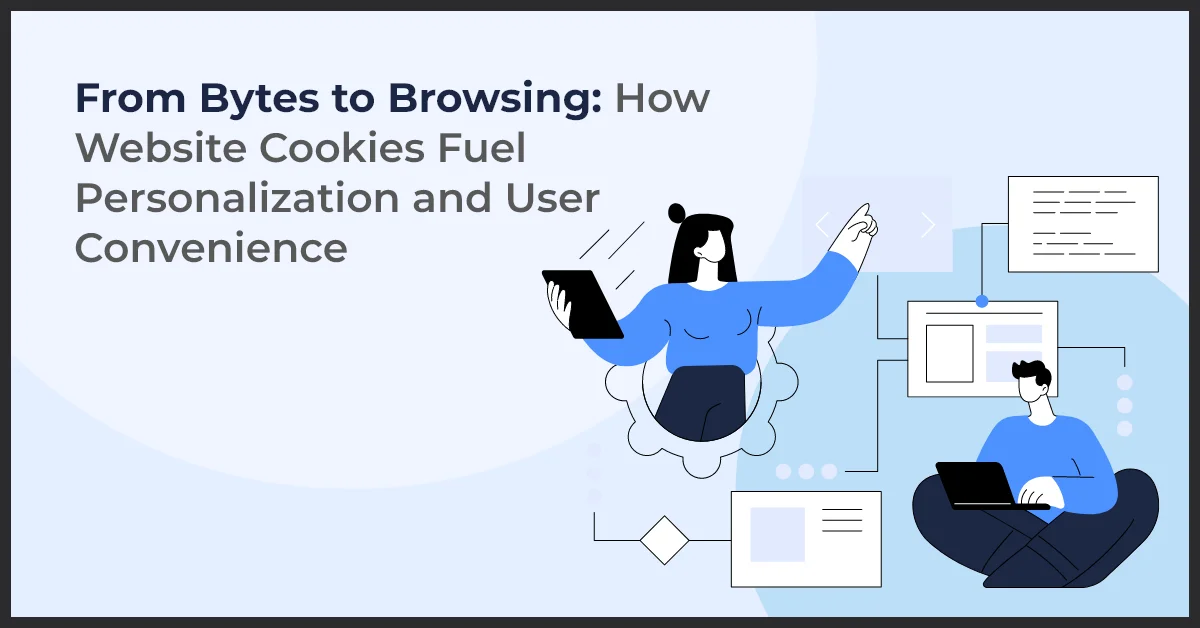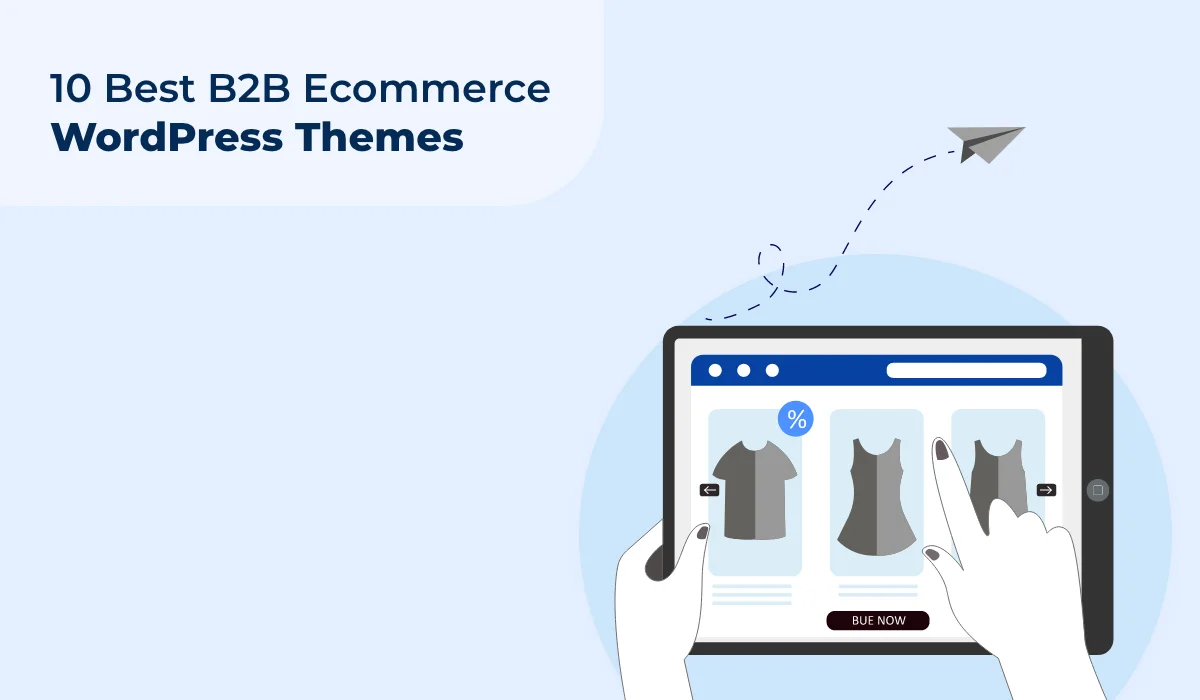From Bytes to Browsing: How Website Cookies Fuel Personalization and User Convenience

Published on: June 12, 2023
Updated on: July 10, 2024
869 Views
- Web Development
15 min read
Website cookies are like the secret ingredients that add flavor to your online experience. They are critical in making your online experience more enjoyable and customized. These handy small text files, which are saved on your device, serve as a memory bank for websites, allowing them to remember your preferences, follow your behavior, and serve you material customized especially for you. In this post, we'll go deep into the realm of website cookies and discover how they work their magic by storing information and tracking your online movements.
Picture this: you go to your favorite online retailer, and it identifies you right away. It recognizes your name, favorite language, and even the things in your virtual shopping cart. How does it accomplish this? It's all because of those astute cookies. They save information such as your login information, language preferences, and those enticing things you were admiring. So the next time you come in, you won't have to go through the effort of inputting everything again. It's like having a pleasant waiter who remembers your order even if you don't say anything.
However, cookies are more than just a store of memories. In their spare time, they also work as sly trackers, keeping an eye on your internet activities (don't worry, it's not as weird as it sounds). They take track of the websites you visit, the links you click, and the interactions you have. This useful information enables websites to learn more about you than your go-to barista knows about your coffee preferences. Websites can better offer up material that is relevant to your interests, create user-friendly webpages, and ensure that the advertisements you see truly grab your attention by learning about your browsing behavior.
In this article, we'll explore the different types of website cookies and dive into how they work their magic in more detail.
The significance of managing website cookies
While cookies offer advantages it is imperative for website owners to prioritize the management of these cookies. This does not ensure the privacy and protection of user data. Also helps in complying with data protection regulations, like the General Data Protection Regulation (GDPR).
In today's age safeguarding data privacy and protecting user information has become a concern. Proper management of website cookies empowers individuals to have control over their privacy settings allowing them to decide whether they want to accept or reject cookies. By implementing management practices website owners can build trust and confidence among their users by assuring them that their information is secure.
Furthermore compliance with data protection regulations such as GDPR holds importance. GDPR mandates that websites must obtain consent from users before placing any essential cookies. By ensuring compliance website owners can avoid complications and potential penalties.
Understanding User Consent and Compliance
User consent plays a role in cookie management. Websites are required to obtain consent from users before placing any cookies on their devices except for cookies that are necessary for the basic functionality of the website.
The enactment of the General Data Protection Regulation (GDPR) by the European Union has had an impact on how websites manage their cookies.
It enforces regulations regarding the safeguarding of data and mandates that websites inform users about the use of cookies. It also requires websites to give users options for managing their cookie preferences and obtain their consent before collecting any information.
To sum up, website cookies play a role in improving user experience. However it is equally important to manage them to ensure data privacy, protection and compliance with regulations. By understanding the types of cookies implementing cookie consent mechanisms and adhering to data protection regulations, like the GDPR website owners can prioritize user trust and safeguard data while providing a personalized browsing experience.
Types of Website Cookies
Session Cookies
Temporary cookies known as session cookies are essential for supporting user sessions on websites. Session cookies are set and saved on your device when you visit a website. These cookies, which are specific to your session and hold data that enables the website to recognize you as you explore its pages, are unique to your session.
Throughout your stay, they facilitate smooth interactions and preserve consistency. For instance, session cookies make sure that you stay signed in while you go between pages, eliminating the need for repeated authentication. Additionally, they save temporary information about your session, such as incomplete forms or things put in a shopping cart. Session cookies are automatically removed once your session is over to protect your privacy.
Persistent Cookies
Compared to session cookies, persistent cookies last longer. These cookies are used to keep track of user preferences and settings, enabling websites to remember you and tailor your experience across visits. Persistent cookies are files that a website stores on your computer or other device after you visit it and that include data about you and your preferences.
For instance, a website may employ a persistent cookie to keep track of your preferred language, theme, style, or even font size. These cookies are retrieved the following time you visit the website, and the website automatically adapts to your choices to provide you with a more convenient and personalized experience. Contrary to session cookies, persistent cookies continue to exist even when your browser is closed or your session ends, preserving your settings.
First-Party Cookies
The website you are now on sets first-party cookies. These cookies are essential to the operation of the website you are visiting and come from its domain. They are employed to offer the services you anticipate and improve your browsing experience. Your login information, products in your shopping cart, user preferences, and other information particular to the website may all be stored in first-party cookies.
For instance, they could save your preferences for presenting information in a certain format or remember your username so you don't have to input it each time you come. First-party cookies are necessary for the website to run efficiently and to provide you with a customized experience that meets your preferences.
Third-Party Cookies
Cookies from websites other than the one you are now viewing are known as third-party cookies. These cookies are obtained from other sources including analytics companies, social media sites, and advertisements. The main purpose of third-party cookies is to monitor user activity and compile data from various websites.
They make it possible for marketers and content creators to send tailored adverts, assess the success of marketing initiatives, and learn more about user preferences and interests. For instance, third-party cookies are frequently to blame when you visit a website and see advertisements that are pertinent to your most recent searches or browsing history.
These cookies keep track of your online behavior across several websites and create an interesting profile, enabling marketers to show you tailored adverts that are based on your choices. Though, the privacy implications of third-party cookies have drawn more attention and concern, leading to conversations and actions targeted at their regulation and restriction.
Cookie Policy and Consent Management
Crafting an Effective Cookie Policy
When it comes to managing cookies on a website, having a comprehensive cookie policy is crucial. A crafted cookie policy should cover the following aspects;
1. Clear and concise explanation; Provide a concise explanation of why cookies are used on the website.
2. Types of cookies; Inform users about the types of cookies being used such, as session cookies, persistent cookies or third party cookies.
3. Lifespan of cookies; Explain how long these cookies remain active on the users device.
Best Practices for Managing Cookie Consent
Respecting user privacy through cookie consent management is essential. Here are some best practices to consider;
1. Clear consent pop ups: Create transparent and easy to understand cookie consent pop ups that clearly explain the purpose of using cookies and offer options for users to accept or decline them.
2. User friendly preferences interfaces: Design cookie banners and preferences interfaces that're user friendly allowing users to easily customize their cookie settings according to their preferences.
Ensuring Compliance with User Consent
To guarantee compliance with user consent it's important to implement mechanisms for obtaining and managing consent. This can be achieved by;
1. Implementing a cookie consent management tool: Utilize a tool that collects and stores user consent preferences related to cookies.
2. Regularly reviewing and updating preferences: Continuously. Update cookie preferences based on the choices made by users respecting their privacy preferences.
By following these guidelines you can create a cookie policy while respecting user privacy through consent management.
Cookie Generation and Storage
Cookies are essential to how websites work since they improve user experiences and allow for more individualized interactions. In this part, we'll go into great depth on how websites create cookies, send them to users' browsers, and then store them on their devices. We will also draw attention to key characteristics of cookies, such as their domain, route, and expiration date. Let's explore each aspect in depth:
Generation of Cookies
A website's server creates cookies when you visit it using code-included instructions. The precise characteristics of the cookies, such as their name, value, etc., are described in these instructions. Websites can modify these parameters so that the behavior and function of the cookies are tailored to their own needs. These cookies are then included in the server's reply to your browser.
Transmission to the User's Browser
Cookie generation and transmission to the user's browser take place simultaneously. The website's server sends the cookies to your browser after they have been created. The automated and transparent transmission takes place as part of the conversation between the server and your browser. Typically, the HTTP headers of the server response contain the cookies. The browser extracts the cookies and gets them ready for storage after getting the answer.
Attributes of Cookies
a. Expiration Date
The website can set an expiration date for each cookie. The cookie's storage time on your device is determined by its expiration date. Your browser deletes the cookie when the expiration date comes around. Session cookies, for example, expire when your browser is closed or your session is over. Long-lived cookies, on the other hand, remain on your computer for a considerable amount of time, enabling websites to remember your preferences and offer customized experiences across different visits.
b. Domain
The cookie's related domain is specified by the domain property. It specifies the cookie's domain and lists the websites that are permitted to access and retrieve it. A cookie that has been created for the domain "example.com" can, for instance, be accessible by any of its subdomains, such as "blog.example.com" or "store.example.com." This characteristic allows for seamless customization across linked subdomains and websites.
c. Path
The path property specifies the particular website path or directory that the cookie is connected to. The transmission of the cookie is limited to pages along the designated path. Ensuring that the cookie is relevant and delivered back to the server only when traveling along the intended path, this characteristic maximizes efficiency and reduces needless data transmission.
Both website developers and users must have a solid understanding of these characteristics. Websites may control the lifespan of cookies by using the expiration date, balancing the need for personalization with privacy concerns. The domain and path characteristics allow for focused cookie access and transmission, enhancing user experiences.
The Lifecycle of a Cookie
Creation of a Cookie
The lifespan of a cookie starts with its creation when a website creates and places a cookie on a user's browser. As was mentioned previously, the cookie is created by the website's server and is sent together with the server's response to the browser. The properties of the cookie, such as its name, value, and expiration, are specified by the server.
Storage of the Cookie
The cookie is saved on the user's device after it has been received by the browser. Cookies are managed by the browser, which makes sure they are kept safe and connected to the particular website that produced them. Cookies are normally saved in a specific folder or database that is handled by the browser, however, the storage location and technique may vary depending on the browser.
Retrieval of the Cookie
The browser retrieves the pertinent cookies related to that website when you visit it again or go to a different page within the same website. For the server to tailor the browsing experience depending on the data saved, the retrieved cookies are then sent back to the website's server with each subsequent request.
It is significant to remember that a website may specify an expiration date for cookies. The cookie's storage duration on the user's device is determined by its expiration date. The cookie is immediately deleted by the browser once its expiration date has passed, erasing it from the user's device. This makes the expiration date a crucial component of efficiently managing cookies.
The expiration date serves several purposes:
Managing Cookie Lifespan
Website owners may manage the cookie's lifetime by specifying an appropriate expiration date. Temporary data storage is made possible via transient cookies, such as session cookies, which vanish as soon as your browser is closed or your session ends. Conversely, long-lived cookies have specified expiration dates that are longer in duration, enabling websites to remember user preferences and provide personalized experiences over multiple visits.
Ensuring Privacy and Security
By preventing cookies from being kept indefinitely, the expiration date helps to provide user privacy. Browsers reduce the danger of unwanted access by automatically erasing expired cookies from the user's device, removing potentially sensitive information.
Enabling Optimal Functionality
By setting suitable expiration dates, you can make sure that cookies are always current and relevant. Cookies that are too old or stale could not correctly represent a user's present preferences or decisions. Websites may deliver more accurate and individualized experiences by setting cookie expiration times that are appropriate for their use.
Managing Website Cookies
Accepting or Declining Cookies
When a user first visits a website, a cookie consent banner or popup is frequently displayed. Users are allowed to accept or deny cookies in these banners, which also explain how the website uses them. Users often have the option to accept all cookies, accept just necessary cookies, or set their own preferences by accepting or rejecting particular cookie types. Users may choose whether to enable websites to store and access cookies on their devices by carefully examining their options.
Clearing Cookie Data
By choosing to clear their cookie data, users may effectively delete all cookies from their browsers. You can accomplish this by using the privacy settings or browser settings. Users who wish to start again might benefit from clearing their cookie data, which gets rid of any previously saved data or cookie-related settings. It's crucial to keep in mind that deleting cookie data could also lock users out of websites and reset personalized settings, necessitating a new login and preference customization process.
Blocking Certain Cookies
Users can modify the settings in their browsers to block certain cookies or to stop websites from setting any cookies at all. Browsers frequently include tools to control cookie settings, such as the ability to ban cookies from certain domains or third parties. By prohibiting websites from tracking user behavior and collecting data, blocking cookies can improve privacy. It's crucial to keep in mind, though, that disabling some cookies could affect how well-functioning some websites are. A less-than-ideal browsing experience could result from disabling some cookies that may be necessary for certain functionality or tailored experiences.
Practical Steps, for Managing Website Cookies
A. Tracking Cookies and User Privacy
- Distinguishing between essential and non essential tracking cookies
- Strategies for tracking user activity while respecting privacy
B. Techniques for Efficient Cookie Management
- Implementing tools or plugins to manage cookies
- auditing cookies and their purposes
C. Strategies for Transparent Data Privacy
- Educating users about cookie usage and data collection practices
- Providing options for users to control their data preferences
Website Cookie Management and its Impact on Digital Advertising
Understanding the Role of Cookies in Digital Advertising
Website cookies play a crucial role in personalized digital advertising. These small text files enable advertisers to track user behavior, preferences and interactions on websites allowing them to deliver targeted ads that're more relevant to users.
- How cookies facilitate personalized advertising.
- Balancing data collection for ad targeting with user privacy considerations.
The Impact of Cookie Management on Digital Advertising Practices
However managing cookies has presented challenges in advertising practices. Concerns regarding internet privacy and data protection have led to the implementation of restrictions on cookie usage. These limitations restrict the amount of data that can be collected and stored through cookies making it more challenging for advertisers to deliver ads.
Overcoming Advertising Challenges, in the Face of Cookie Restrictions
With the increasing limitations on cookies in advertising it becomes paramount for advertisers to navigate this changing landscape and discover approaches to effectively target their desired audience. As we explore advertising strategies it is vital to embrace user approaches that comply with regulations. Let's delve into techniques for targeted advertising within a cookie restricted environment.
Conclusion
Transparency and user control are paramount in managing website cookies. By providing clear information and options, users can make informed choices about their cookie preferences. It is important to empower users to accept or decline cookies, clear their data, and configure browser settings accordingly. By prioritizing transparency and user control, individuals can navigate the balance between personalization and privacy. For further assistance, reach out to info@growthnatives.com or call +1 855-693-4769. Take charge of your cookie settings today for a safer and tailored online experience.



